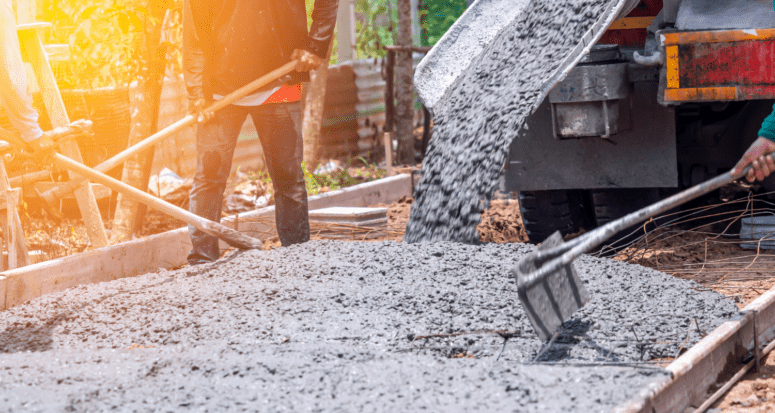How to Fix Driveway Cracks for a Smooth (and Safe) Home Entrance
- Published on
- 5-6 min. read
-
 Melissa Rudy Contributing AuthorClose
Melissa Rudy Contributing AuthorClose Melissa Rudy Contributing Author
Melissa Rudy Contributing AuthorMelissa Rudy is a seasoned digital journalist with 15 years of experience writing web copy, blog posts and articles for a broad range of companies. When she can’t buy or sell homes, she settles for the next-best thing: researching and writing about all things real estate-related.
A driveway can last up to 50 years while enduring the pressure of nature’s harsh elements and the weight of your 4,000-pound SUV. But like your roof and patio, it will show signs of wear and tear, most noticeably in the form of cracks that lead to unsightly weeds poking through. If the cracks criss-crossing the driveway are large enough, they can also pose a safety issue.
“Just about every driveway will have some degree of cracking as it settles,” says Andrew Poe, a top real estate agent in Knoxville, Tennessee. “If the cracks are minor and don’t cause any height differential, it’s usually not a concern. But if there are significant cracks, or if an area of the driveway has lifted, perhaps from a tree root, it could create a tripping hazard that might deter buyers at resale.”
Fortunately, you can make efforts to restore your driveway and extend its lifespan. We spoke with Michael Hayworth, owner of a North Carolina residential concrete company since 1998, about when it makes sense to repair driveway cracks yourself, the best way to tackle the project, and signs that you’ll need to bring in a professional.

Concrete vs. asphalt driveways
Most driveways are made from either concrete or asphalt. Both are made from a blend of sand and crushed stone (also referred to as “aggregate”). The main difference is that each uses a different type of material to bind the loose aggregate together.
- With concrete, cement acts as the binding agent for the sand and crushed stone. The cement — which is a blend of powdered rock, clay, and water — mixes with the crushed stone and sand to create concrete. Concrete driveways are usually a lighter grey color, and can be customized with stamped designs to mimic the look of brick or paver stones.
- Asphalt driveways are also made from aggregate, but they are bound by asphalt, a petroleum-based material that is similar to tar. Also known as a “blacktop” driveway, this type of surface is usually black or dark-brown, and tends to get hot in sunny climates with high temperatures.
What causes concrete driveways to crack?
In an ideal world, your concrete driveway will stay smooth and seamless for decades to come. But the more realistic scenario is that over time — even when the concrete was poured with the utmost skill and with quality materials — some settlement cracks will start to appear. They commonly start as hairline cracks, and then as the concrete settles due to voids or lateral movement, the cracks gradually widen.
Concrete Supply Company, a ready-mix concrete provider in business since 1958, breaks down some of the most common types of concrete driveway cracks:
- Expansion cracks: If you live in a climate that has high temperatures, the heat can cause the concrete to expand and push up against the materials adjacent to it, such as the side of a house or the surrounding concrete. Over time, this can cause the concrete to crack.
- Heaving cracks: These types of cracks often appear after the concrete freezes and thaws repeatedly. When it freezes, it can lift up significantly and then return to its original position as it thaws. Heaving cracks can also be caused by tree roots growing underneath the concrete.
- Overloading cracks: It might seem like concrete is a virtually indestructible material, but there are limits to how much weight it can bear before it begins to crack. The strength of concrete is measured in pounds per square inch (PSIs). A typical four-inch driveway made from standard concrete has a PSI of around 2,500. If you plan to keep very large vehicles, dumpsters, or other heavy items in your driveway, you might want to invest in thicker concrete.
- Cracks from premature drying: If a concrete slab dries too quickly, it can cause “crazing cracks” (very fine surface cracks) or “crusting cracks,” which can sometimes appear when concrete is stamped into patterns or textures.

Repairing concrete driveway cracks
According to Hayworth, a concrete pouring expert, you can’t technically repair a crack in the sense that once it forms, it will always be there. However, you can seal the crack with hydraulic cement purchased from your local hardware store or Home Depot.
If the cracks in your concrete driveway are less than one inch wide, you should be able to fill them yourself by following these steps:
1. Check the weather forecast
For the best results, look for a window of time when there will be at least 48 hours of good weather so that the materials will have enough time to dry thoroughly. Mild temperatures are best for this job; ideally, the concrete surface should be at least 50 degrees before starting the repair process.
2. Clear and clean the surface
Start by clearing away any debris or plant growth from the cracks. If you’ll be resurfacing the entire driveway, sweep the concrete or use a leaf blower to remove loose items, and then use a power washer to remove dirt. Allow the concrete to dry completely.
3. Make a plan based on the severity of the cracks
- If your driveway has fine, superficial cracks on the surface, you can use a concrete resurfacer to create a smooth, like-new surface. Concrete resurfacing eliminates imperfections at a fraction of the cost of re-pouring a new driveway. When resurfacing, you can even choose to add decorative patterns or textures, such as the look of brick or stone, to create a custom look. This tutorial video from QuikRete walks you through the process.
- For cracks that are less than 1/4 inch wide, you can use a concrete crack filler designed to fill small cracks. Try to find a quick-drying or fast-setting filler so you can start using the driveway as soon as possible. Many fillers come ready to use with a built-in nozzle for easy application. Self-leveling fillers should settle easily into the crack, but if needed, you can use a putty knife to smooth out the filler and remove any excess.
- When repairing cracks that are wider than 1/4 inch, Hayworth recommends using a concrete backer rod. This is a piece of styrofoam that is inserted into the crack before applying the filler, which allows you to use less hydraulic cement and creates a smoother end result.
Common types of asphalt cracks
Like their concrete counterparts, asphalt driveways can also start to crack over time. There are several different types of asphalt cracks:
- Fatigue cracking: These cracks tend to appear when the asphalt isn’t strong or thick enough to handle the weight placed on it. These are sometimes called “alligator cracks” because they resemble an alligator’s skin.
- Edge cracking: When an asphalt driveway doesn’t have enough edge support, cracks will sometimes appear vertically along the edges.
- Longitudinal cracking: These cracks run vertically down a driveway and are usually a reaction to improper construction or shrinkage of the asphalt.
- Transverse cracking: These types of cracks run across a driveway, a common result of asphalt shrinkage or a ripple effect from an existing crack.
- Slippage cracking: Often caused by a combination of pressure from vehicle weight and a poor-quality asphalt mix, slippage cracks appear as crescent-shaped depressions on the driveway.
- Block cracking: These large cracks usually appear in a rectangle shape, and are typically the result of shrinking asphalt as temperatures rise or fall.
- Reflection cracking: These types of asphalt driveway cracks stem from previous cracks that exist deeper in the old layers of pavement.

Repairing asphalt driveway cracks
Repairing asphalt driveway cracks is a different process than repairing concrete cracks:
- Check the weather forecast. As with concrete cracks, make sure there will be at least 48 hours of dry, warm weather.
- Clean the surface. Use a trowel, screwdriver, or wire brush to move any rocks, plant matter, or other debris from the crack, and then power-wash the asphalt. Allow the driveway to dry completely before moving to the next step.
- Fill the cracks with sand. This has a dual benefit: It cuts down on the amount of tar you’ll need to buy to repair the crack, and it also allows for more movement and reduces the chances of future cracking.
- Use an asphalt crack filler or a flex sealant to fill the remainder of the crack. Hayworth recommends applying the filler with a caulk gun and then using a hand tamper to pressure the sealant into place so that it’s level with the driveway. Allow it to dry for 24 hours, then apply a second coat if needed. Wait one to two more days before walking or driving on the spot that’s been refilled.
- Re-seal the surface. After sealing cracks in an asphalt driveway, you will likely see lines where the cracks have been sealed. Because of this, most people opt to then re-seal their driveway after repairing cracks.
When to call in the pros
While most smaller driveway cracks can be resolved with some moderate DIY skills, the right tools, and a little patience, you may want to contact a professional if you’re dealing with any of these more complicated problems:
- Large cracks wider than 1 inch
- Cracks that vary in width, or have uneven, jagged heights
- Extensive cracks that cover a large portion of the driveway
- Buckling or sinking concrete
- Cracks that continue to reappear after you have already repaired them
In your search for a driveway contractor, ask your candidates to provide references. Call the clients who’ve worked with the company in the past and ask them about their experience. If possible, go to previous job sites and evaluate the condition of the driveway to see how the contractor’s work has held up. In addition, ask your driveway contractor about how they plan to account for adequate drainage through site grading.
While some hairline cracks and other minor cosmetic imperfections are to be expected as a driveway ages, more significant disruptions can detract from your home’s curb appeal and could even create issues at resale. Whether it’s asphalt or concrete, it is possible to restore your cracked driveway to a certain extent. The key is gauging the severity of the cracks, having the right materials on hand, and getting a professional opinion if the project extends beyond your DIY comfort zone.
Header Image Source: (touch1976 / Shutterstock)
